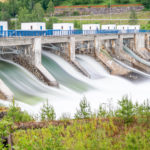How ESG* analysts should think – Dilemmas in the renewable energy utility sector
We have just finished an ESG sector research report on the Norwegian hydroelectric power producers. The descriptive sector report with some of our conclusions can be found here: https://sustainax.docsend.com/view/4yht7yqepwbkymf5
There are a certain number of dilemmas that an ESG analyst stumble over when working on ESG analysis on companies in the renewable energy sectors; hydroelectric, wind and solar power producers. In the sector we find both public and private companies, some big and some smaller.
These dilemmas cannot be avoided and the ESG analyst have to take a stance, how big is the initial risk, how appropriate is the company’s mitigation of the risk and what is the residual risk. Is there enough information and KPIs to judge the residual ESG risk properly?
Some of the sources to the dilemmas is that the problem is historic, that the problem is not spoken about as it is disturbing or does not suit today’s discussion climate, or even worse that the problem is not considered a problem as future innovation is expected to solve it, etc. What is common for many of the dilemmas, is that there is disagreement among the specialists.
Some dilemmas we will be dealing with here:
- Existing plants built in a less demanding context
- Only additional renewable production counts?
- Reduce CO2 emissions at any other environmental and social cost?
- District heating – What to think of the different energy sources?
- Do local communities and nature really always count?
- Talent retention, is this risk fully understood?
- If you say it and wish us to take it into account, show it with KPIs
Number one – Existing plants built in a less demanding context
A number of the existing renewable energy plants would not have been built today, at least not the same way, with the current priority for environmental and social considerations. An exception here can be for non-democratic countries, that may even today ignore these.
Many of these plants have and have had for a long time negative impacts on nature, biodiversity and local communities. Particularly during construction and also in the daily operations. But they were built a time when this was not something that was taken into account.
Examples – Old hydroelectric dam, run of river plants and wind farms. The Three Gorges Dam in China; the dam flooded archaeological and cultural sites, displaced some 1.3 million people, and had caused significant ecological changes including an increased risk of landslides. Because of that, the dam has been controversial both domestically and abroad. Many windfarm projects did not consider the noise that people suffered from in the local community or the grief from losing valuable recreational areas.
How I think as an ESG* analyst – In general, what is in place is in place, not much to do about that, or? What can be done though is to align to the focus and knowledge we have today, by amending the installations to improve the conditions for nature, biodiversity and local communities. Keep in mind also that what has been in place for a long time is closer to both renewal/refurbishment of equipment and renewal (or not) of the operating licence, keep an eye on these risks.
Number two – Only additional renewable production counts?
This is about the ESG opportunity. To produce renewable energy is good, but what we really need now is additional production of renewable energy. Does a renewable energy producer contribute to the SDGs or mitigate the climate crisis with existing production or is this only through additional production?
Examples – An historic hydroelectric power producer is providing renewable energy, fine. But do they contribute to solve the climate crisis if there is no increase in production? If they stop, the contribution would be negative. Of course, if used as a “battery” for intermittent renewable energy production is a contribution, as it then acts as a renewable enabler for other technology.
How I think as an ESG* analyst – As I see this it is really only with additional renewable production and when acting as a renewable “battery” or enabler for other renewable energy production that a company can contribute and that way have a real ESG opportunity. But for sure the company benefits from lower financing costs simply by being a renewable energy producer even without extending capacity. Being a producer that adds renewable production (directly or indirectly) is likely taking down financing costs further at this would qualify for impact investors as well. A larger pool of potential investors may lead to bigger interest, hence lower financing costs.
Keep in mind that an “ESG opportunity” company may have ESG risks at the same time, see next point. This is often ignored in the market’s drive for the so called “ESG stocks” (I do not like this meaningless expression) that we have seen in the last years.
Number three – Reduce CO2 emissions at any other environmental and social cost?
If the renewable energy plant contributes to reduction in CO2, is it ok to ignore all other negative environmental or social effects?
This plays out in two dimensions, the first is the electrification of the society and the other is the lifecycle of the equipment in the production (from production process until the recycling of the equipment, including environmental and social factors)
For the electrification trend, all is great for CO2 reduction and other pollution where the fossil energy is consumed (or translated to electricity), but what about the new products, equipment and supply chains it requires?
For the equipment life cycle, we often have very little visibility where this is produced, by who and in what conditions. We see little in the company sustainability reports or climate accounting from companies that takes this into account. A life cycle also includes the recycling when the equipment is decommissioned.
Some companies have very clear policies on the requirement imposed on suppliers, but few details if they do audits of the suppliers.
Examples – Wind power plants consume quite some quantities of metals, plastics and other resources. This includes basic metals (body) to rare earth metals (magnets). The latter are produced in regions where we know there are issues both from an environmental and social point of view. Dirty mining in inhuman conditions, local communities with polluted drinking water. Solar panels also contain a number of ingredients of origin that is not always transparent on environmental and social aspects. Recently the accusation of China using slaves in the production of solar panels and European companies saying they will continue to buy them anyhow as there is no other alternative is an example to think about. Recycling of wind farm blades and solar panels are discussed with many diverging voices on the real recycling possibilities.
How I think as an ESG* analyst – This is a very difficult area, but in all cases what we as ESG analysts would like to see it that the companies are transparent. Talk about this, to let us know that you are aware of it. Maybe there are mitigating strategies in place already? The companies may have no solution to this today but let us know if you at least have plans to change it and how. This said, a plan is good, but if current production includes dirty mining polluting local community drinking water or inhumane mining with child labour, there is absolutely no excuse. And if we as ESG analysts have no clear information, we simply cannot exclude that you are exposed to such risk.
Number four – District heating – What to think of the different energy sources?
Most companies talk about their district heating activities as pure renewable energy, period. Someone generates heat and pollute, but that is not “our” problem, we just take the heat and use it. The heat would not have been used if we did not use it, therefore it is at no environmental cost.
How I think as an ESG* analyst – I prefer that the companies are transparent on how much GHG and other pollution that comes out of biomass and waste incineration. And of course, top up fossil fuel usage. This because the heat recuperation, at least from waste incineration, can actually hinder initiatives to find other better ways to destruct the waste. On the biomass side there is still a lot of discussion on the GHG accounts. It would be very useful to have details about how the incineration process is, how the GHG and other pollution is dealt with.
Number five – Do local communities and nature really always count?
“All” say they take local communities and nature into account when planning a new renewable energy plant. But how much does this weigh really?
How many dams, solar or wind projects have been stopped in the world due to this? When the license is allocated to a company, they have in reality been given the right to do it by the government or local authorities. Does this mean that the management of local communities or other groups that initiate controversies in the end is only about silencing them at the lowest cost?
We also see that in some countries a “nature audit” has to be conducted by a specialist that the operating company is hiring. We have seen for instance in Norway that areas having been graded as top priority to preserve, suddenly is not that important to preserve as the wind is very regular and strong there. This has recently put hard breaks on land-based wind generation in Norway, due to community protests with strong feelings.
How I think as an ESG* analyst – This must be a difficult task for the operating companies, a balancing act where they already know the outcome? If a company have a lot of controversies with local communities, NGOs and other groups of interest, it is for me an indicator that the company may not take this as seriously as they should and needs to be studied closer.
Number six – Talent retention
Talents in renewable energy will likely be chased by other companies and may be hard to replace with experienced talents going forward. For listed companies it is easier to retain talents with share option and equity programs.
How I think as an ESG* analyst – For public and private companies (for instance municipality and PE owned companies) not having the equity as a tool to retain talents this is a clear risk without answer. Or at least they need to help us understand how they can mitigate the risk of losing core competency and experience. Transparency.
Number seven – If you say it, show it with KPIs
We have seen the emergence of glossy sustainability reports with positive contributions to the SDGs and high-level statements of goals and approaches. And most companies have a lot of policies. But unfortunately, not always followed up by tangible evidence that this really mean anything.
Example 1 – “We take H&S and anti-corruption seriously and have a new policy”. Great! But without a programme ensuring that the employees actually have had a teach-in ensuring they are aware of it and have learned it, it is not very powerful.
Example 2 – “Our suppliers have to align to our code of conduct, anti-corruption and H&S policy”. Great! But how is this put in place and how often are there real audits?
How I think as an ESG* analyst – It is great that companies publish sustainability reports, but the more they say, the more we also expect in terms of tangible data to make is credible. The key word here is KPIs. If companies say they do something, we expect them to show this to us by measurable KPIs. In the example 1 above, what is the % of the employees having done a real training in the policy? And what is the % of the employees having passes the test quiz? It is great that there is an increased focus on the supply chain, the time of “not our” problem is over. In the example 2 above, we would like to know if the suppliers have to sign the adherence to code of conduct and other policies? Will they be audited? KPIs can be the % of suppliers having signed the adherence, % having been audited, % having lost their contract, % having breached the adherence. All of this would show us the company takes the supply chain responsibility very seriously and count positive in the ESG risk analysis. Actually, a company boasting how sustainable they are without really showing us how, tend to be treated rougher than a more modest company with the same low level of KPIs.
Conclusions – How ESG* analysts should think – Dilemmas in the renewable energy utility sector
Whatever the reasons for the dilemma, as ESG analysts we always seek to see if the company is dealing with it, if they have no solution or the current trends do not see it as a problem, we demand that the company at least tell us they are aware of the potential risks. If they do, we know they are aware. If they do not, we do not know if they see the potential risks and that will come in as a negative contributor to the conclusion of the ESG analysis of the company.
And frankly speaking, we have to be honest and transparent about this. As is well stated by the UN, when contributing positively for some SDGs it is normal also to contribute negatively for other SDGs, it is the total balance that counts. Companies should be transparent about this. As an ESG analyst I’m not a fan of SDG reporting by companies at they mostly use it to look good. If they could add all the SDGs where they have a negative contribution also, it would be valuable as it would be not only present one side.
Finally, as an ESG analyst I see it as my job to get all extra-financial risks up to the surface or out of the shadow. If I see a risk and the company is doing nothing or not enough to mitigate the risk, it will impact negatively my assessment of the company in the ESG analysis.
As usual, the way to go is Engagement! At the end of all company ESG research we do on companies we always have a list of questions to ask the company.
Engagement can lead to:
- Improved transparency on how the company deals with perceived ESG risk, given they actually do more than they have communicated
- Better ESG risk/opportunity understanding by the company itself of their own activities, leading to better mitigation initiatives
Both of these typically lead to higher ESG score.
We have just finished an ESG sector research report on the Norwegian hydroelectric power producers. The descriptive sector report with some of our conclusions can be found here: https://sustainax.docsend.com/view/4yht7yqepwbkymf5




